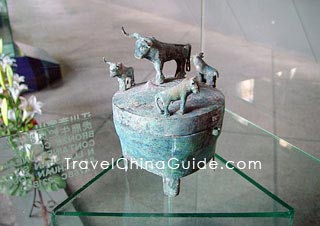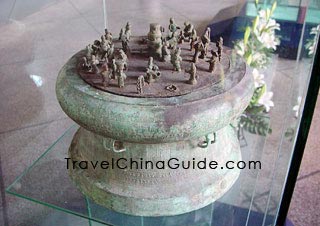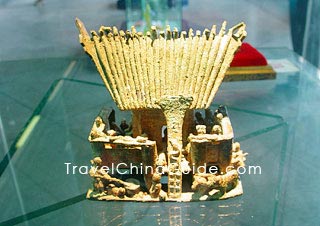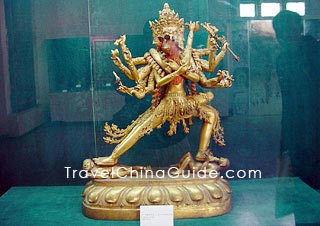Kunming History
![]() Prehistoric Time
Prehistoric Time
Although the existing Kunming City is just 2,400 years old, the earliest activities of human beings in this region can be traced back to over 30,500 years ago. In the light of archaeological finds, primitive people settled in the area around the current Dianchi Lake in the Neolithic period. Apart from agricultural production, these primitive people also earned their living by fishing, hunting and stock raising. Therefore, the Dianchi region is also considered to be one of the important cradles of humankind. ![]() Dian Kingdom
Dian Kingdom
 |
| Bronze Coin Container (476BC-221BC) |
It is worth mentioning that the various kind of bronze vessels made in this period have gained high praise. Either for their workmanship or in their pattern and color, the bronze vessels discovered in the sites of the Dian Kingdom can compare with those ones made in the Central Plains. As a result, it is said that the first peak of the Kunming's civilization appeared in the Dian Kingdom.
![]() The Self-development of the Dian Region
The Self-development of the Dian Region
 |
| Bronze artifacts in Yunnan Museum |
However, due to the incapability and unrest of the later Jin Dynasty (265-420), the Dian region was, in effect, controlled by the strong local Family Cuan. In the early Sui Dynasty (581-618), Dian was one of several prosperous and rich regions in southwest China. However, the Sui's Emperors declared and waged warfare against the Family Cuan who suffered a gradual decline from then on. At the same time, the Emperor founded Kunzhou City here. In 746-747 of the Tang Dynasty (618-907), the Family Cuan was captured by its strong neighbor Nanzhao State which set up its political center in the Dali City and gained much support from the Tang's Emperor.
![]() The Further Development in the Yuan and Ming Dynasties
The Further Development in the Yuan and Ming Dynasties
 |
| Cultural relics showing civilization in history |
However, the majority of Kunming residents were descended from backward barbarian tribes until the arrival of the Ming Dynasty (1368-1644). In order to counterbalance the population, the government organized a great number of Han immigrants and soldiers to go to the Dian region. In 1382, the local government started to reconstruct the city, a new wall was built around the city. It was just the preliminary layout of the current Kunming City. Apart from that, a number of villages around the city proper were also built for the soldiers to live in. Nowadays, these villages are some of the featured toscen in the suburbs.
![]() The Unsteady Development in the Qing Dynasty
The Unsteady Development in the Qing Dynasty
 |
| Sculpture of Vajri |
In December 1949, Kunming City was liberated peacefully and confirmed as the capital of Yunnan Province. Now, it is a beautiful tourist destination, being full of the exotic flavors of southwest China.
- Last updated on Jul. 18, 2022 -